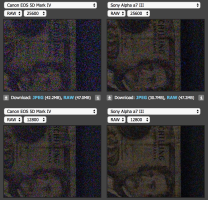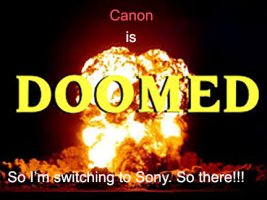Hflm said:
There are things like churches, which often are very dark in Germany (all over Europe, to be more precise) and flashes aren't usually allowed at all. Very easy to end up at ISO 12800 at f2.8 with a 70-200 or 24-70.
I guess I live in a different part of the world. I have never attended a wedding ceremony at which camera flashes were not permitted.
As a groom or bride I would not want my wedding memorialized at ISO 12,800. In that case, forget the video, because it would look like the Blair Witch Project

If it came to that, I'd choose a different venue.
I haven't met any wedding photographers that shoot most of their stuff at 5 digit ISOs. I'll take your word that in your part of the world they exist... I sure pity them, even more so, their customers.
Hflm said:
Otherwise, we use flashes of course, but we and our clients don't like dance floor images looking like normal daylight images. Doesn't reflect the mood well, looks often artificial and people don't find it nice if our big Profoto's would fire constantly to lit the full place.
Flashes done right don't look like normal daylight images. If you're using flashes well, they should look very natural, and folks looking at the photography shouldn't even be able to tell that you're using a flash.
Put it another way. If they have "that flash look", you're doing it wrong.
Hflm said:
Regarding focussing: setting effect off, all our Sony lenses open up the aperture and I can focus as fast as in good light ...
Using Sony lenses at wide open apertures, one should hope that autofocus in good light isn't an issue

But wait... What? A camera should be able to focus when it ISN'T a wide open aperture. And when there ISN'T good light. A Canon DSLR can!
There are plenty of reasons. You take corporate headshots at F/11, for example. And sometimes, there's just less light. I don't mean nightclub dark; just mood lighting dim. Like AF on cat that's lit by the fireplace

Anyways, autofocus with Sony lenses, even in poor light, I think is tolerable, but there is
lots of room for improvement.
Hflm said:
The Godox system works extremely well. With x1ts one even has AF assist light. But the most reliable triggers for me were the Phottix Strato ii ones, I used with Nikon and Canon alike. With Mitros+ or Juno I can trigger all Stratos with SB910 or Rx600 flashes if required, too. Where is the problem? The Elinchrom and Profoto works extremely well, too.
I always find it funny to hear sarcastic comments from people like you, who obviously don't know what they are talking about.
It wasn't a sarcastic comment at all.
First, my biggest point of dissatisfaction with Sony flashes. The hotshoe looks like this:
And the flash receptacle looks like this:
It is so damned fragile with its stupid pins that both the hotshoe and the flash need covers on them when not in use. And, you actually need to cover the Sony hotshoe if nothing is in it... just to prevent problems with rain.
How crazy is that?
In my opinion, Phottix is an overpriced system considering that its build quality isn't really that great (not much better than Godox), with a limited number of options. You're basically stuck with Odin + Mitros if you want HSS. I'd suggest that if you want remote triggers, Cactus is a better way to go, because you can get HSS out of other brands of flashes. If you don't care about HSS and you're just going to use the flashes manually, I would suggest, just use a single contact transmitter and someone else's flashes.
I think Godox is your best bet with Sony. But that is really, really sad. I mean, these are NEEWER flashes, for heaven's sake. When that's your
best flash option, including Sony's own, I think that my point that Sony's flash ecosystem is the poorest of all the major brands is a statement of fact, not an opinion or sarcasm. Let me point out that they aren't weather sealed at all. And, their build quality is terrible, worse and more inconsistent than Yongnuo flashes. While there isn't anything
wrong with them, they're not very rugged. I know that in the Canon world, most photographers that rely on speedlights would much rather use the 1st party Canon flash than the Yongnuo knockoff (and certainly not the Godox ones).
On the Godox transmitter end, you have your choice between the reasonably nicely built transmitter that has terrible ergonomics (X1T-S) or the really nice ergonomic one (XPro-S) with the beautiful display, that is made cheaply, and has some bugs. Also, the flash illuminator on the Godox hotshoe flashes made for Sony don't actually work on Sony bodies. Why is that?
On the upside, Godox has a series of strobes which are natively compatible with the 2.4Ghz system. Not that they're really great strobes or anything, but they're ok for a basement studio.
Regarding Profoto and Elinchrom: I was talking specifically about flashes, not studio strobes. Since I don't have Sony transmitters, I couldn't tell you how well this works or not.
Now, Sony has a really nice wireless transmitter. What they should do... is build a GN60 flash that actually works with it. That shouldn't be so hard, right? But hey, it will have those ridiculous pins on the bottom.




